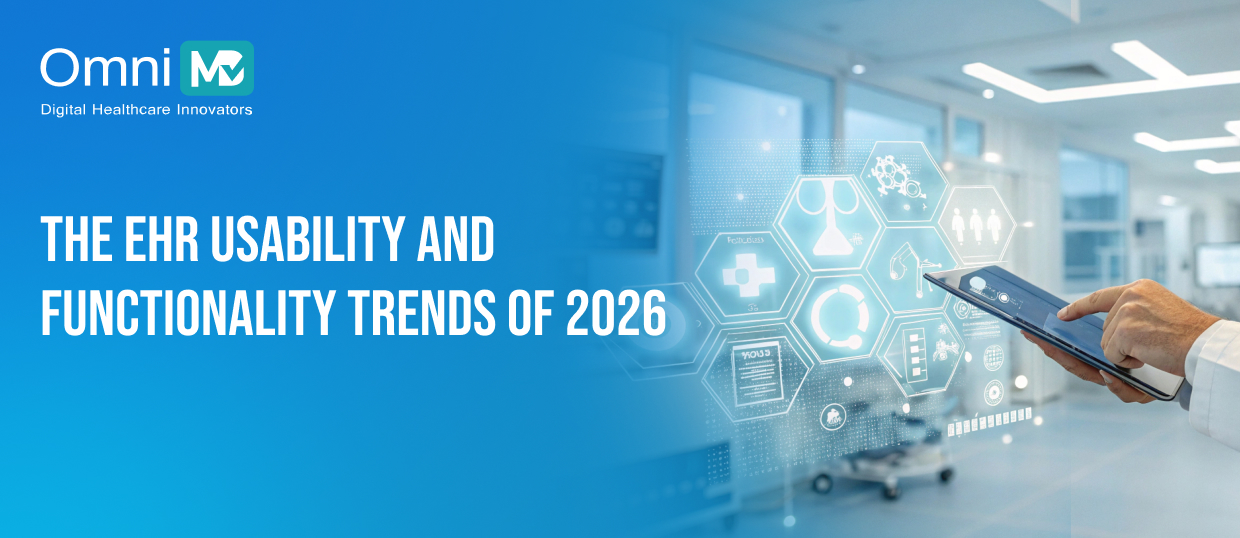7 Game-Changing EHR Advancements of 2026
In 2026, EHR technology has entered a new era where intelligence, automation, and connected systems define clinical performance. Today’s platforms unify EHR, PMS, RCM, Telehealth, and RPM into a single ecosystem, supported by AI tools that accelerate documentation, structure operations, and strengthen revenue.
If you’re evaluating a new EHR in 2026, here are the advancements that are truly transforming practices and will define the next decade of healthcare.
1. The Rise of AI-Driven Care Delivery (AI Scribe, AI Front Desk, AI Clinician)
The biggest evolution in EHRs is the expansion of AI from “a helpful add-on” to “the engine behind the clinical workflow.”
Modern EHRs now embed:
- AI Medical Scribes
Real-time ambient listening, conversation-to-chart documentation, automated summaries, structured notes, and coding suggestions, reducing charting time by up to 70%.
- AI Front Desk Assistants
Call triage, appointment scheduling, routing, intake, eligibility checks, and follow-up automation… all handled even before the staff hears the call.
- AI Clinician Assistants
Symptom intake, risk scoring, differential suggestions, diagnostic insights, and predictive models that help clinicians make faster, safer decisions.
- AI-Driven Quality Measures & Compliance
Real-time prompts for MIPS, documentation gaps, care plans, and population health analytics.
AI has become the bridge between clinical accuracy, operational efficiency, and financial outcomes, something legacy EHRs never imagined.
2. Unified Platforms: EHR + PMS + RCM + Billing + Telehealth + RPM in One Ecosystem
Fragmented systems are officially over. The new generation of EHRs brings all essential systems under one cloud:
- EHR (clinical workflows)
- Practice Management (scheduling, portals, eligibility, reminders)
- Revenue Cycle Management (coding, claims, denials, ERA/EOB posting)
- Telehealth (video visits, e-prescribing, virtual care)
- Remote Patient Monitoring (device data, alerts, care plans)
- Population Health & Analytics
A unified platform eliminates:
- Data duplication
- Manual entry
- Integration failures
- Billing delays
- Compliance risks
- Information silos
Practices now operate inside one connected patient journey, and not five disconnected software tools.
3. Intelligent Interoperability (FHIR APIs, HIE, Device Integration, Real-Time Sync)
Interoperability has become more than ‘systems talking.’ It’s now about data understanding.
New EHR infrastructures support:
- Real-time data exchange through advanced FHIR APIs
- HL7 + X12 integration for labs, hospitals, payers
- Connected RPM devices (BP cuffs, weight scales, glucose monitors, wearables)
- Predictive analytics from shared datasets
- Cross-platform scheduling, referrals, authorizations, and e-prescriptions
Modern interoperability ensures:
- No repeat tests
- No missing patient history
- No inconsistent charting
And most importantly, continuous care across every touchpoint.
4. Workflow Automation from Intake to Reimbursement
EHRs have evolved from “documentation systems” to workflow engines. Automations now run:
- Intake workflows
Digital forms → real-time sync to chart → insurance checks → clinical intake summaries
- Clinical workflows
Auto-populated templates → AI-generated notes → coding powered by clinical context
- Operational workflows
Reminders, follow-ups, task automation, routing, escalation, flags, queue management
- Billing & RCM workflows
Eligibility → coding → charge capture → scrubbing → claims → payments → analytics
Automation is now the core expectation of any future-proof EHR.
5. Specialty-Optimized Clinical Experience (Templates, Workflows, AI Models)
Generic EHRs are dead. Clinicians now expect hyper-specialized tools, including:
- Condition-specific templates
- Specialty dashboards
- Diagnosis-based automation
- AI models trained on specialty datasets
- Imaging, labs, and procedure workflows
- Built-in scoring systems
- Automated coding for ICD-10, CPT, E/M
- Pathway-based care plans
A cardiologist, pediatrician, dermatologist, orthopedist, and urgent care physician should NOT be using the same documentation blueprint, and modern EHRs reflect that.
6. Telehealth And Digital Front Door: The Always-On Clinic
Telehealth is the default access point now. The new EHRs integrate:
- Virtual visits
- Secure messaging
- e-Prescribing
- Digital check-ins
- Online scheduling
- AI-powered triage
- Call-to-visit conversion tracking
- Post-visit automation
Patients expect care to be available from anywhere, and practices expect data to update everywhere.
Modern systems deliver exactly that.
7. RCM-Integrated EHRs: Revenue is No Longer an Afterthought
Modern EHRs treat revenue like a clinical priority. Integrated RCM ensures:
- 98%+ first-pass claims
- Automated coding recommendations
- Real-time eligibility on every appointment
- AI-driven denial prediction and correction
- Auto-posting of ERAs & EOBs
- Patient financial engagement
- Revenue dashboards for every provider
With financial, operational, and clinical workflows united, revenue leakage finally disappears.
How to Choose a Next-Gen EHR in 2026
Here’s what every forward-thinking clinic should evaluate:
- Does it unify EHR + PMS + RCM + Telehealth + RPM?
- Does it offer AI that actually reduces workload (not just buzzwords)?
- Are specialty workflows and templates included?
- Does automation exist across intake → visit → billing?
- Are templates, dashboards, and workflows customizable?
- Does it meet all compliance standards (HIPAA, ONC, FHIR, MIPS)?
- Is the system scalable for multi-location groups?
- Does the vendor provide billing services or RCM support if needed?
Remember, the right EHR will run your clinic!
Why OmniMD Leads This New Phase of EHR Evolution
OmniMD is built for modern, AI-powered, revenue-optimized healthcare delivery.
Our cloud ecosystem delivers:
- Integrated Platform
- EHR + PMS + RCM + Telehealth + RPM in one system.
- AI-Driven Tools: AI Scribe (ambient documentation), AI Front Desk (calls, triage, scheduling), AI Clinician (charts, insights, predictions). And AI Billing & RCM automation
- Specialty-Optimized Workflows: 40+ specialties with templates, scoring tools, and tailored pathways.
- Advanced Interoperability: FHIR, HL7, HIE networks, labs, hospitals, pharmacies, devices.
- Revenue-Centric Operations: Automated coding, clean claims, denial prevention, analytics, and full service medical billing.
Talk to Our Experts & See the Future of EHRs Today
Transform how your clinic documents, schedules, engages, and gets paid.
Experience OmniMD’s AI-powered ecosystem firsthand.

Top EHR Features You Can’t Ignore!
See What Sets the OmniMD EHR Apart

 Written by Dr. Giriraj Tosh Purohit
Written by Dr. Giriraj Tosh Purohit